Critical Evaluation of Health Preventive Programs in Public Health
VerifiedAdded on 2022/08/22
|10
|2638
|24
Report
AI Summary
This report offers a critical evaluation of four evidence-based preventive medicine programs: the Franklin Cardiovascular Health Program (FCHP), Best Practices for Comprehensive Tobacco Control Programs, Obesity Prevention and Promotion of weight loss in Primary Care Programs, and the COPD National Action Plan. The report analyzes the programs' objectives, strategies, and outcomes, discussing the implementation of health strategies. It highlights the benefits and drawbacks of each program, providing a comprehensive overview of their effectiveness in addressing cardiovascular disease, tobacco use, obesity, and COPD. The analysis includes discussions on program benchmarks, interventions, and their impact on public health, while also identifying the challenges faced during implementation.
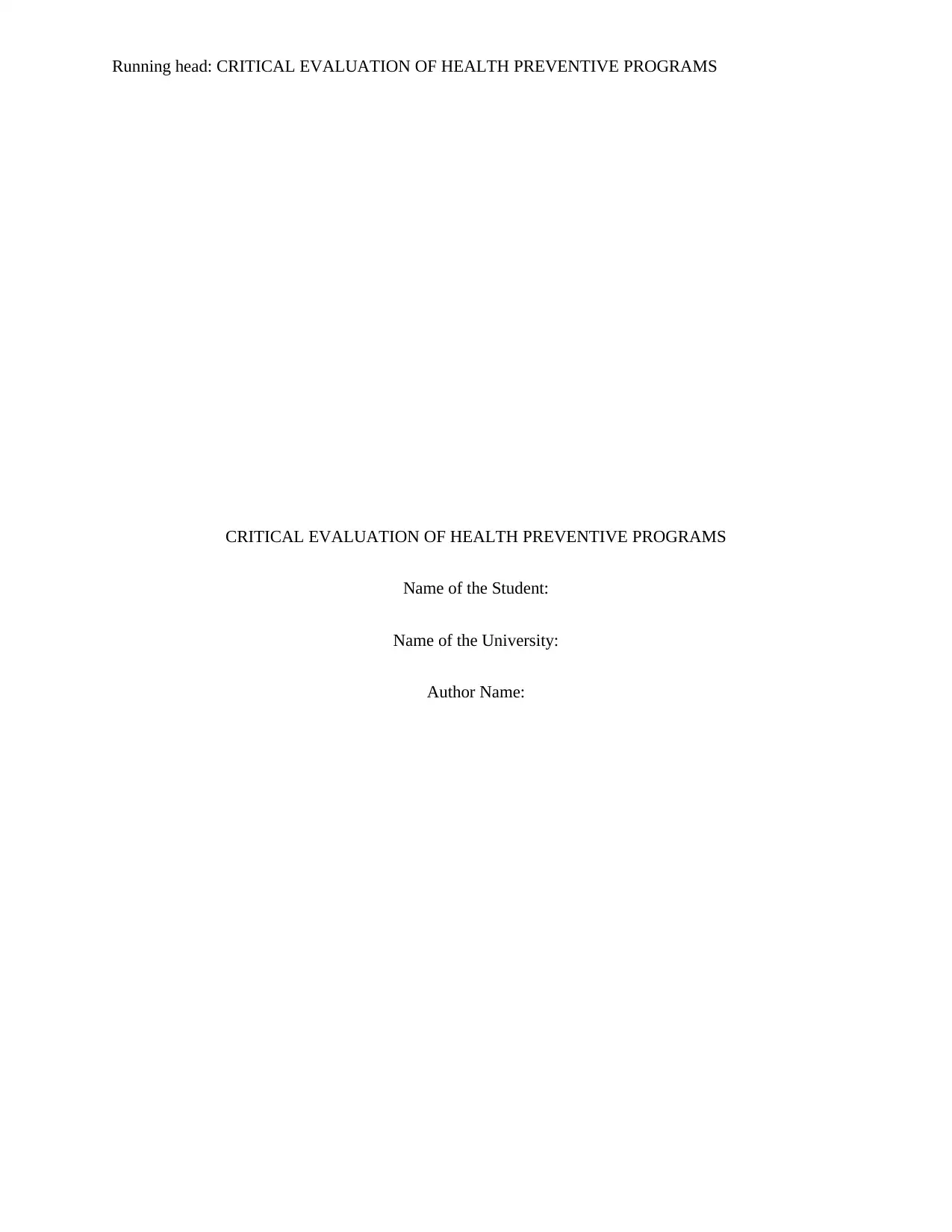
Running head: CRITICAL EVALUATION OF HEALTH PREVENTIVE PROGRAMS
CRITICAL EVALUATION OF HEALTH PREVENTIVE PROGRAMS
Name of the Student:
Name of the University:
Author Name:
CRITICAL EVALUATION OF HEALTH PREVENTIVE PROGRAMS
Name of the Student:
Name of the University:
Author Name:
Paraphrase This Document
Need a fresh take? Get an instant paraphrase of this document with our AI Paraphraser
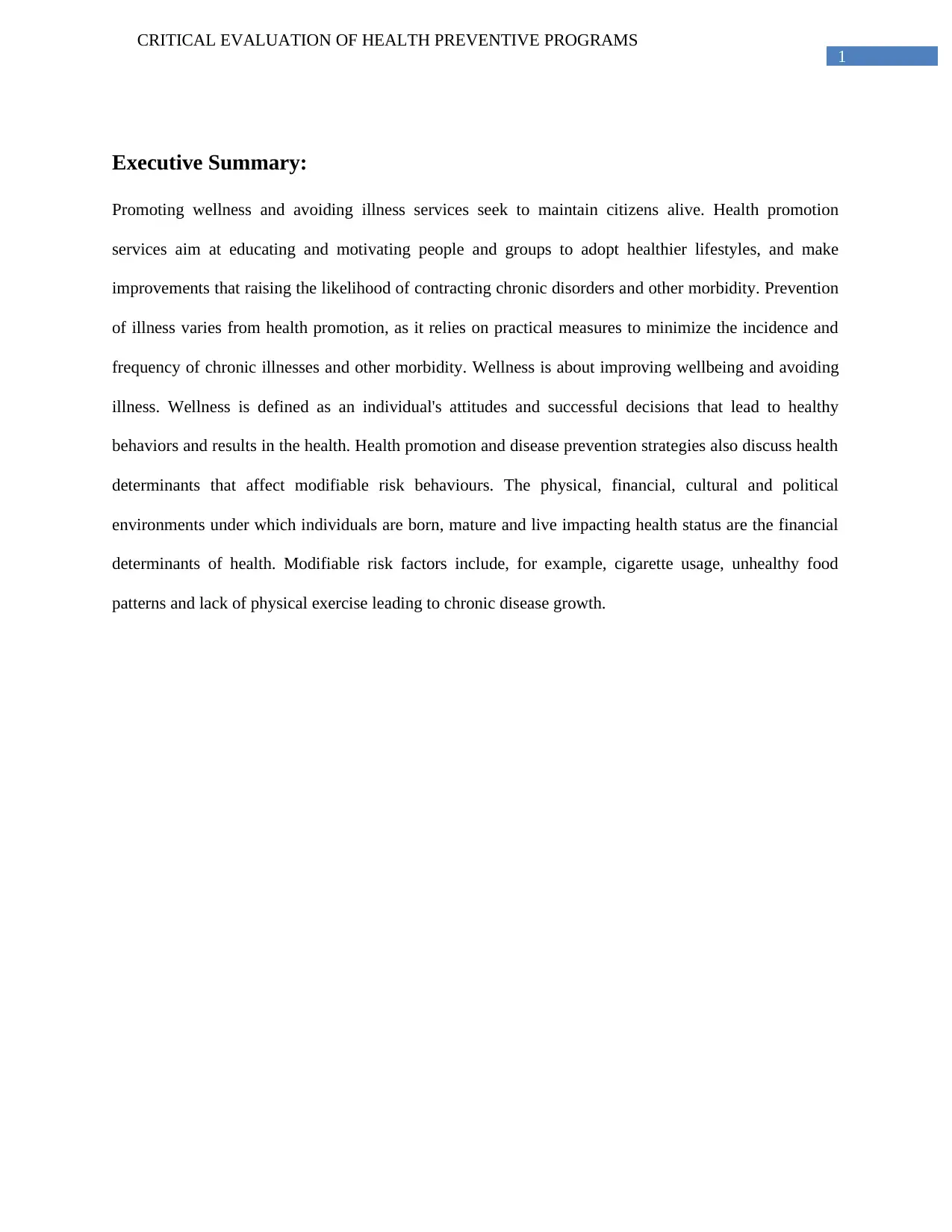
1
CRITICAL EVALUATION OF HEALTH PREVENTIVE PROGRAMS
Executive Summary:
Promoting wellness and avoiding illness services seek to maintain citizens alive. Health promotion
services aim at educating and motivating people and groups to adopt healthier lifestyles, and make
improvements that raising the likelihood of contracting chronic disorders and other morbidity. Prevention
of illness varies from health promotion, as it relies on practical measures to minimize the incidence and
frequency of chronic illnesses and other morbidity. Wellness is about improving wellbeing and avoiding
illness. Wellness is defined as an individual's attitudes and successful decisions that lead to healthy
behaviors and results in the health. Health promotion and disease prevention strategies also discuss health
determinants that affect modifiable risk behaviours. The physical, financial, cultural and political
environments under which individuals are born, mature and live impacting health status are the financial
determinants of health. Modifiable risk factors include, for example, cigarette usage, unhealthy food
patterns and lack of physical exercise leading to chronic disease growth.
CRITICAL EVALUATION OF HEALTH PREVENTIVE PROGRAMS
Executive Summary:
Promoting wellness and avoiding illness services seek to maintain citizens alive. Health promotion
services aim at educating and motivating people and groups to adopt healthier lifestyles, and make
improvements that raising the likelihood of contracting chronic disorders and other morbidity. Prevention
of illness varies from health promotion, as it relies on practical measures to minimize the incidence and
frequency of chronic illnesses and other morbidity. Wellness is about improving wellbeing and avoiding
illness. Wellness is defined as an individual's attitudes and successful decisions that lead to healthy
behaviors and results in the health. Health promotion and disease prevention strategies also discuss health
determinants that affect modifiable risk behaviours. The physical, financial, cultural and political
environments under which individuals are born, mature and live impacting health status are the financial
determinants of health. Modifiable risk factors include, for example, cigarette usage, unhealthy food
patterns and lack of physical exercise leading to chronic disease growth.
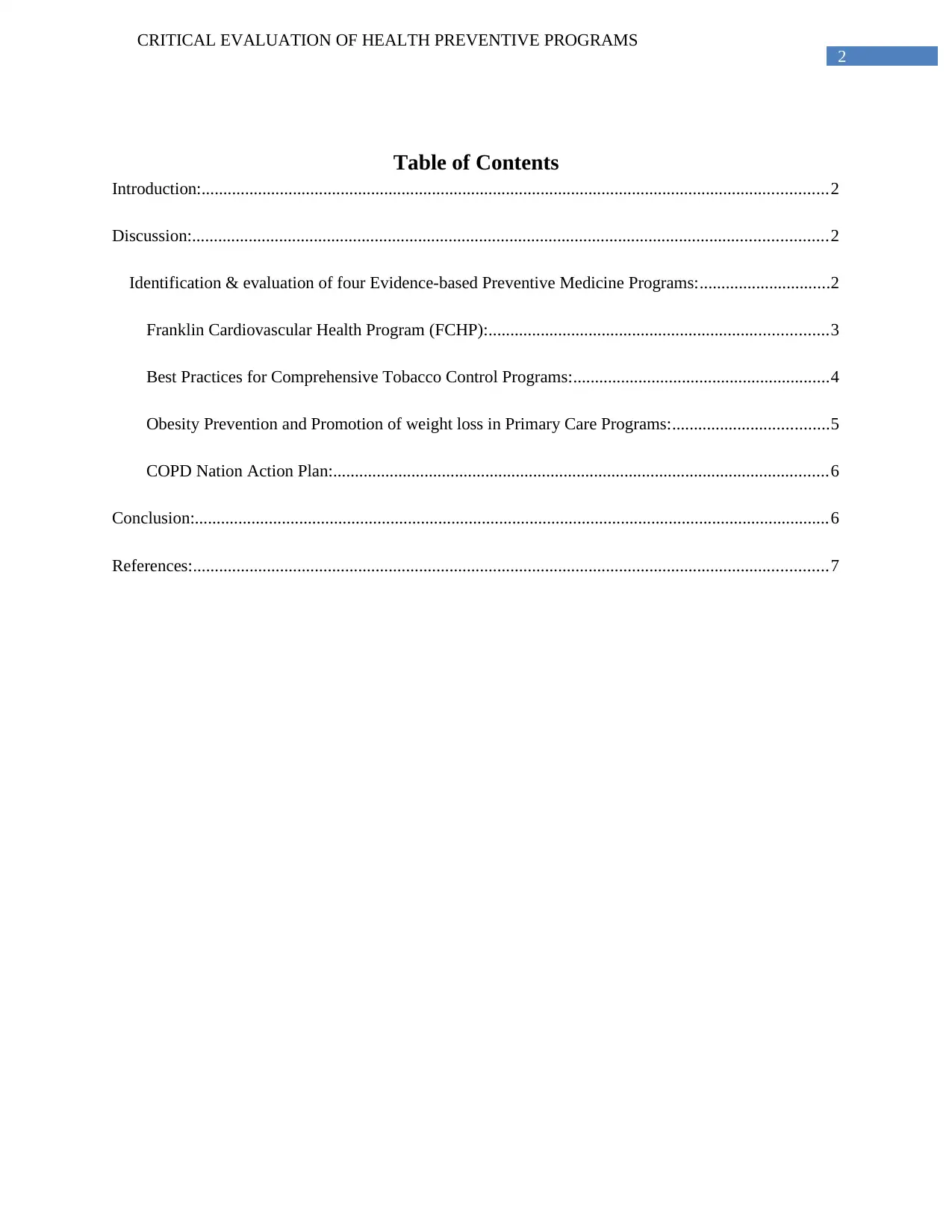
2
CRITICAL EVALUATION OF HEALTH PREVENTIVE PROGRAMS
Table of Contents
Introduction:................................................................................................................................................2
Discussion:..................................................................................................................................................2
Identification & evaluation of four Evidence-based Preventive Medicine Programs:..............................2
Franklin Cardiovascular Health Program (FCHP):..............................................................................3
Best Practices for Comprehensive Tobacco Control Programs:...........................................................4
Obesity Prevention and Promotion of weight loss in Primary Care Programs:....................................5
COPD Nation Action Plan:..................................................................................................................6
Conclusion:..................................................................................................................................................6
References:..................................................................................................................................................7
CRITICAL EVALUATION OF HEALTH PREVENTIVE PROGRAMS
Table of Contents
Introduction:................................................................................................................................................2
Discussion:..................................................................................................................................................2
Identification & evaluation of four Evidence-based Preventive Medicine Programs:..............................2
Franklin Cardiovascular Health Program (FCHP):..............................................................................3
Best Practices for Comprehensive Tobacco Control Programs:...........................................................4
Obesity Prevention and Promotion of weight loss in Primary Care Programs:....................................5
COPD Nation Action Plan:..................................................................................................................6
Conclusion:..................................................................................................................................................6
References:..................................................................................................................................................7
⊘ This is a preview!⊘
Do you want full access?
Subscribe today to unlock all pages.

Trusted by 1+ million students worldwide
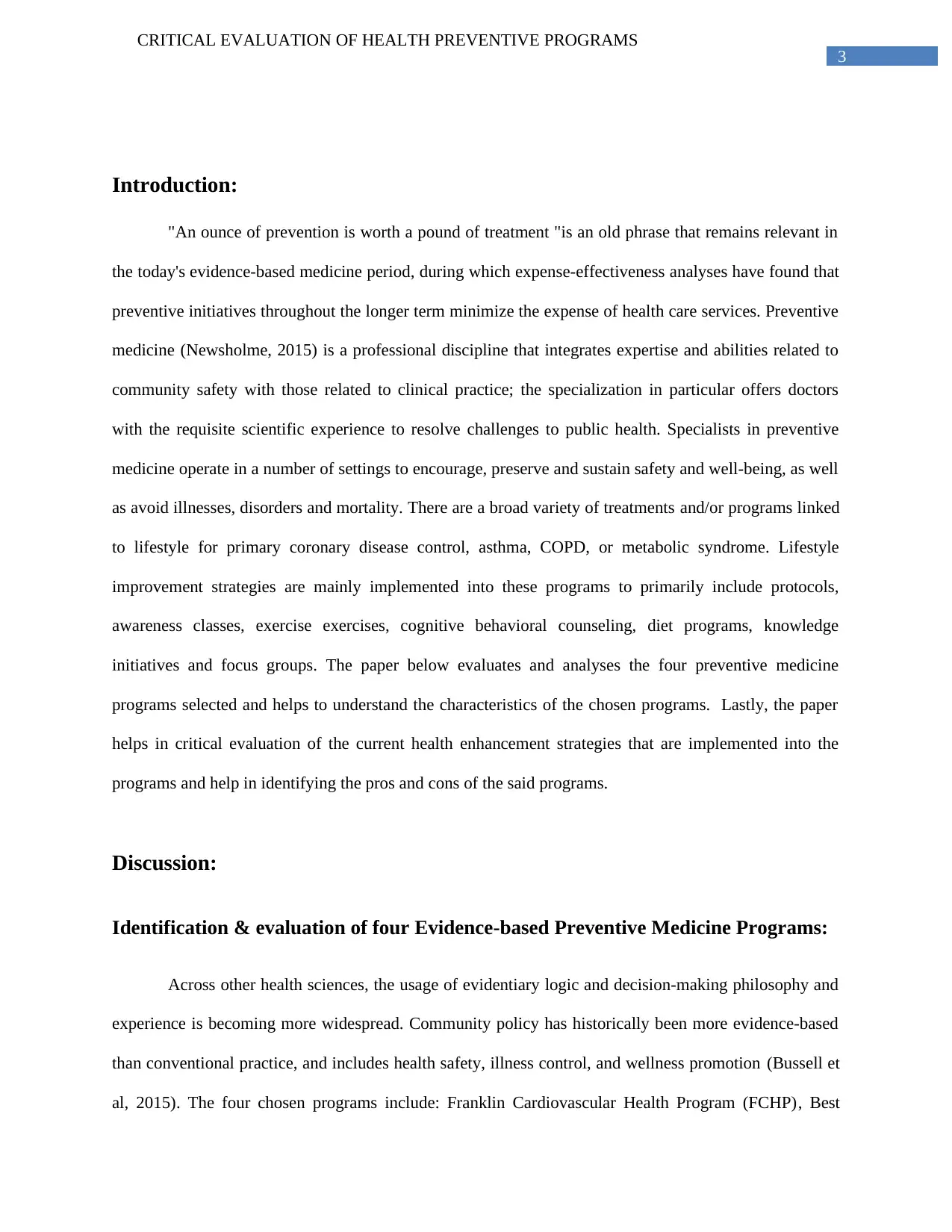
3
CRITICAL EVALUATION OF HEALTH PREVENTIVE PROGRAMS
Introduction:
"An ounce of prevention is worth a pound of treatment "is an old phrase that remains relevant in
the today's evidence-based medicine period, during which expense-effectiveness analyses have found that
preventive initiatives throughout the longer term minimize the expense of health care services. Preventive
medicine (Newsholme, 2015) is a professional discipline that integrates expertise and abilities related to
community safety with those related to clinical practice; the specialization in particular offers doctors
with the requisite scientific experience to resolve challenges to public health. Specialists in preventive
medicine operate in a number of settings to encourage, preserve and sustain safety and well-being, as well
as avoid illnesses, disorders and mortality. There are a broad variety of treatments and/or programs linked
to lifestyle for primary coronary disease control, asthma, COPD, or metabolic syndrome. Lifestyle
improvement strategies are mainly implemented into these programs to primarily include protocols,
awareness classes, exercise exercises, cognitive behavioral counseling, diet programs, knowledge
initiatives and focus groups. The paper below evaluates and analyses the four preventive medicine
programs selected and helps to understand the characteristics of the chosen programs. Lastly, the paper
helps in critical evaluation of the current health enhancement strategies that are implemented into the
programs and help in identifying the pros and cons of the said programs.
Discussion:
Identification & evaluation of four Evidence-based Preventive Medicine Programs:
Across other health sciences, the usage of evidentiary logic and decision-making philosophy and
experience is becoming more widespread. Community policy has historically been more evidence-based
than conventional practice, and includes health safety, illness control, and wellness promotion (Bussell et
al, 2015). The four chosen programs include: Franklin Cardiovascular Health Program (FCHP), Best
CRITICAL EVALUATION OF HEALTH PREVENTIVE PROGRAMS
Introduction:
"An ounce of prevention is worth a pound of treatment "is an old phrase that remains relevant in
the today's evidence-based medicine period, during which expense-effectiveness analyses have found that
preventive initiatives throughout the longer term minimize the expense of health care services. Preventive
medicine (Newsholme, 2015) is a professional discipline that integrates expertise and abilities related to
community safety with those related to clinical practice; the specialization in particular offers doctors
with the requisite scientific experience to resolve challenges to public health. Specialists in preventive
medicine operate in a number of settings to encourage, preserve and sustain safety and well-being, as well
as avoid illnesses, disorders and mortality. There are a broad variety of treatments and/or programs linked
to lifestyle for primary coronary disease control, asthma, COPD, or metabolic syndrome. Lifestyle
improvement strategies are mainly implemented into these programs to primarily include protocols,
awareness classes, exercise exercises, cognitive behavioral counseling, diet programs, knowledge
initiatives and focus groups. The paper below evaluates and analyses the four preventive medicine
programs selected and helps to understand the characteristics of the chosen programs. Lastly, the paper
helps in critical evaluation of the current health enhancement strategies that are implemented into the
programs and help in identifying the pros and cons of the said programs.
Discussion:
Identification & evaluation of four Evidence-based Preventive Medicine Programs:
Across other health sciences, the usage of evidentiary logic and decision-making philosophy and
experience is becoming more widespread. Community policy has historically been more evidence-based
than conventional practice, and includes health safety, illness control, and wellness promotion (Bussell et
al, 2015). The four chosen programs include: Franklin Cardiovascular Health Program (FCHP), Best
Paraphrase This Document
Need a fresh take? Get an instant paraphrase of this document with our AI Paraphraser
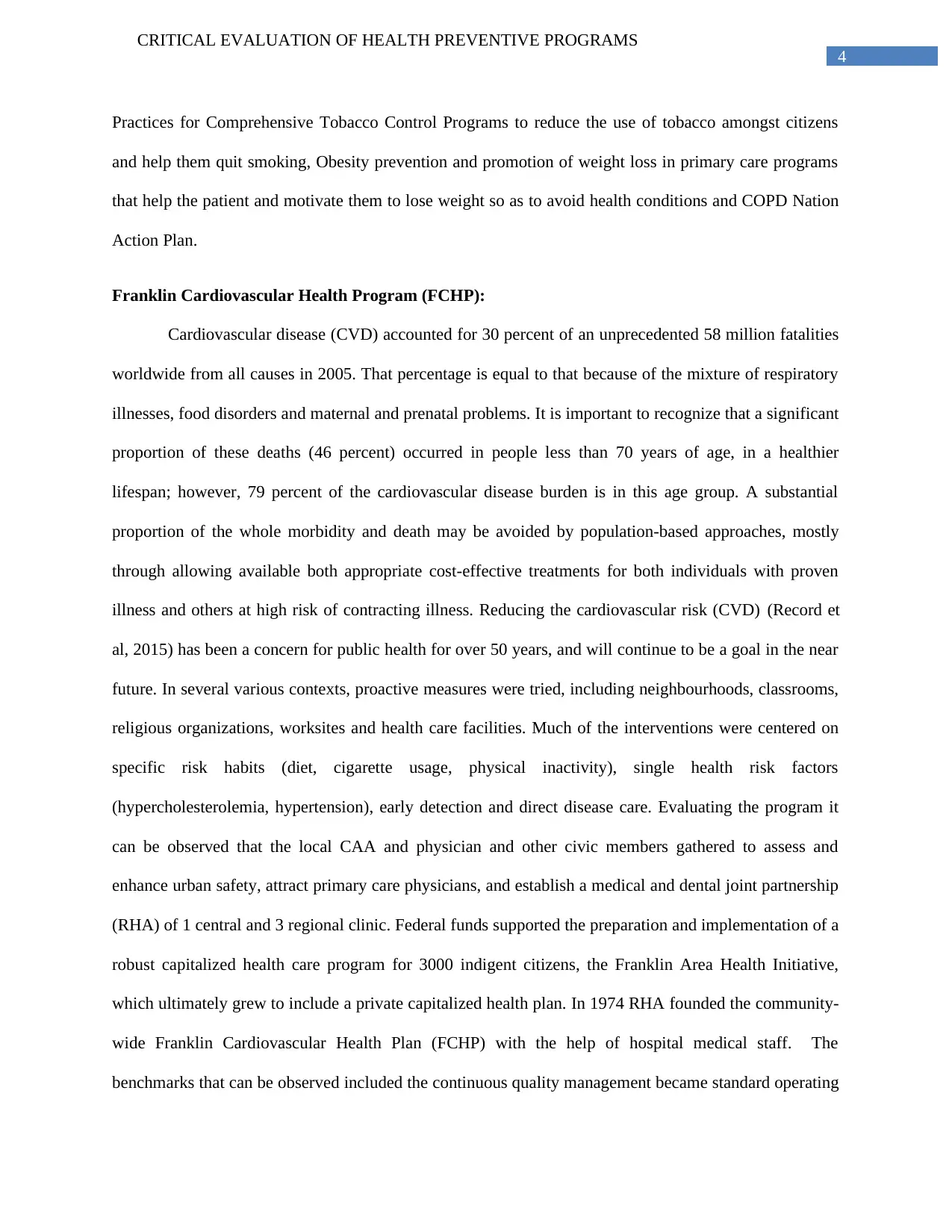
4
CRITICAL EVALUATION OF HEALTH PREVENTIVE PROGRAMS
Practices for Comprehensive Tobacco Control Programs to reduce the use of tobacco amongst citizens
and help them quit smoking, Obesity prevention and promotion of weight loss in primary care programs
that help the patient and motivate them to lose weight so as to avoid health conditions and COPD Nation
Action Plan.
Franklin Cardiovascular Health Program (FCHP):
Cardiovascular disease (CVD) accounted for 30 percent of an unprecedented 58 million fatalities
worldwide from all causes in 2005. That percentage is equal to that because of the mixture of respiratory
illnesses, food disorders and maternal and prenatal problems. It is important to recognize that a significant
proportion of these deaths (46 percent) occurred in people less than 70 years of age, in a healthier
lifespan; however, 79 percent of the cardiovascular disease burden is in this age group. A substantial
proportion of the whole morbidity and death may be avoided by population-based approaches, mostly
through allowing available both appropriate cost-effective treatments for both individuals with proven
illness and others at high risk of contracting illness. Reducing the cardiovascular risk (CVD) (Record et
al, 2015) has been a concern for public health for over 50 years, and will continue to be a goal in the near
future. In several various contexts, proactive measures were tried, including neighbourhoods, classrooms,
religious organizations, worksites and health care facilities. Much of the interventions were centered on
specific risk habits (diet, cigarette usage, physical inactivity), single health risk factors
(hypercholesterolemia, hypertension), early detection and direct disease care. Evaluating the program it
can be observed that the local CAA and physician and other civic members gathered to assess and
enhance urban safety, attract primary care physicians, and establish a medical and dental joint partnership
(RHA) of 1 central and 3 regional clinic. Federal funds supported the preparation and implementation of a
robust capitalized health care program for 3000 indigent citizens, the Franklin Area Health Initiative,
which ultimately grew to include a private capitalized health plan. In 1974 RHA founded the community-
wide Franklin Cardiovascular Health Plan (FCHP) with the help of hospital medical staff. The
benchmarks that can be observed included the continuous quality management became standard operating
CRITICAL EVALUATION OF HEALTH PREVENTIVE PROGRAMS
Practices for Comprehensive Tobacco Control Programs to reduce the use of tobacco amongst citizens
and help them quit smoking, Obesity prevention and promotion of weight loss in primary care programs
that help the patient and motivate them to lose weight so as to avoid health conditions and COPD Nation
Action Plan.
Franklin Cardiovascular Health Program (FCHP):
Cardiovascular disease (CVD) accounted for 30 percent of an unprecedented 58 million fatalities
worldwide from all causes in 2005. That percentage is equal to that because of the mixture of respiratory
illnesses, food disorders and maternal and prenatal problems. It is important to recognize that a significant
proportion of these deaths (46 percent) occurred in people less than 70 years of age, in a healthier
lifespan; however, 79 percent of the cardiovascular disease burden is in this age group. A substantial
proportion of the whole morbidity and death may be avoided by population-based approaches, mostly
through allowing available both appropriate cost-effective treatments for both individuals with proven
illness and others at high risk of contracting illness. Reducing the cardiovascular risk (CVD) (Record et
al, 2015) has been a concern for public health for over 50 years, and will continue to be a goal in the near
future. In several various contexts, proactive measures were tried, including neighbourhoods, classrooms,
religious organizations, worksites and health care facilities. Much of the interventions were centered on
specific risk habits (diet, cigarette usage, physical inactivity), single health risk factors
(hypercholesterolemia, hypertension), early detection and direct disease care. Evaluating the program it
can be observed that the local CAA and physician and other civic members gathered to assess and
enhance urban safety, attract primary care physicians, and establish a medical and dental joint partnership
(RHA) of 1 central and 3 regional clinic. Federal funds supported the preparation and implementation of a
robust capitalized health care program for 3000 indigent citizens, the Franklin Area Health Initiative,
which ultimately grew to include a private capitalized health plan. In 1974 RHA founded the community-
wide Franklin Cardiovascular Health Plan (FCHP) with the help of hospital medical staff. The
benchmarks that can be observed included the continuous quality management became standard operating
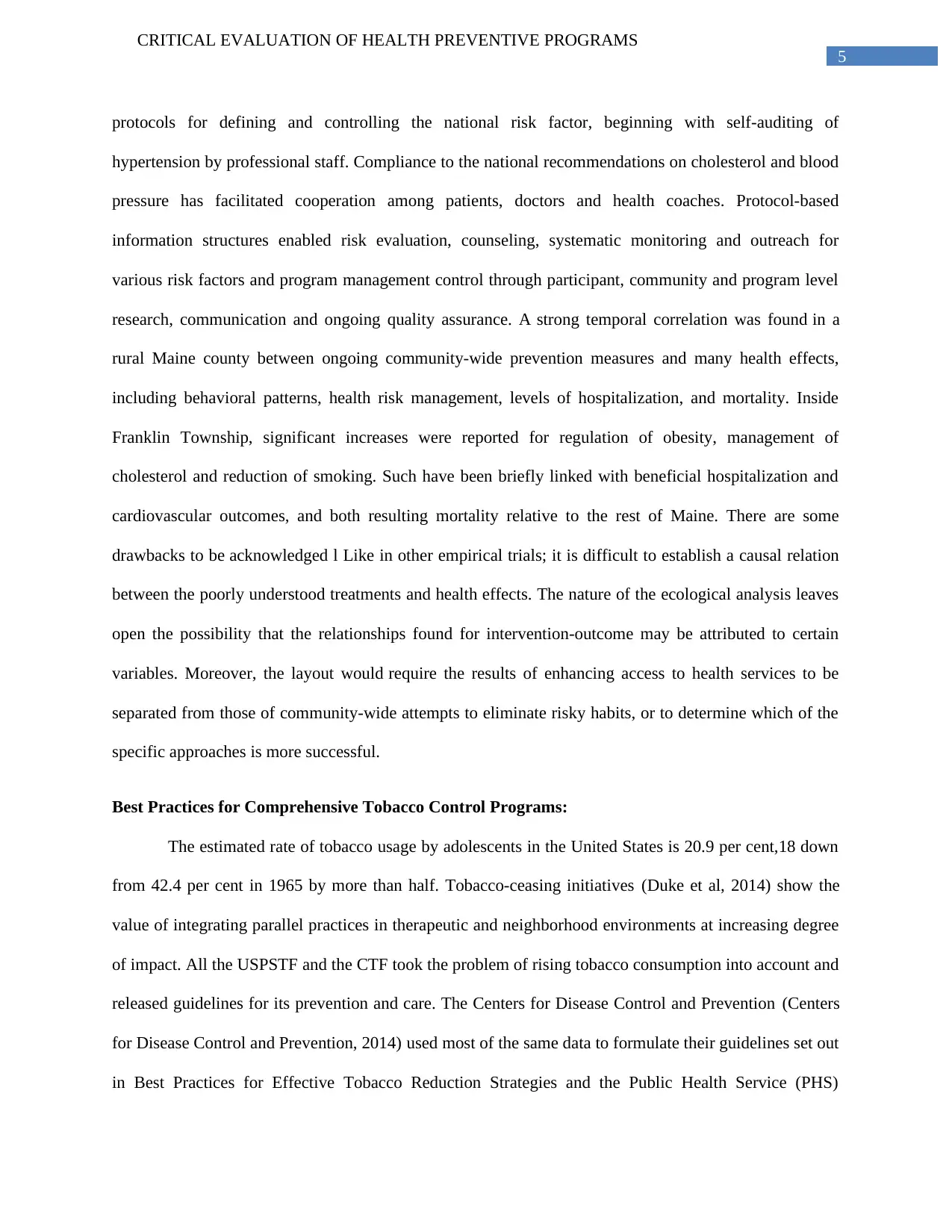
5
CRITICAL EVALUATION OF HEALTH PREVENTIVE PROGRAMS
protocols for defining and controlling the national risk factor, beginning with self-auditing of
hypertension by professional staff. Compliance to the national recommendations on cholesterol and blood
pressure has facilitated cooperation among patients, doctors and health coaches. Protocol-based
information structures enabled risk evaluation, counseling, systematic monitoring and outreach for
various risk factors and program management control through participant, community and program level
research, communication and ongoing quality assurance. A strong temporal correlation was found in a
rural Maine county between ongoing community-wide prevention measures and many health effects,
including behavioral patterns, health risk management, levels of hospitalization, and mortality. Inside
Franklin Township, significant increases were reported for regulation of obesity, management of
cholesterol and reduction of smoking. Such have been briefly linked with beneficial hospitalization and
cardiovascular outcomes, and both resulting mortality relative to the rest of Maine. There are some
drawbacks to be acknowledged l Like in other empirical trials; it is difficult to establish a causal relation
between the poorly understood treatments and health effects. The nature of the ecological analysis leaves
open the possibility that the relationships found for intervention-outcome may be attributed to certain
variables. Moreover, the layout would require the results of enhancing access to health services to be
separated from those of community-wide attempts to eliminate risky habits, or to determine which of the
specific approaches is more successful.
Best Practices for Comprehensive Tobacco Control Programs:
The estimated rate of tobacco usage by adolescents in the United States is 20.9 per cent,18 down
from 42.4 per cent in 1965 by more than half. Tobacco-ceasing initiatives (Duke et al, 2014) show the
value of integrating parallel practices in therapeutic and neighborhood environments at increasing degree
of impact. All the USPSTF and the CTF took the problem of rising tobacco consumption into account and
released guidelines for its prevention and care. The Centers for Disease Control and Prevention (Centers
for Disease Control and Prevention, 2014) used most of the same data to formulate their guidelines set out
in Best Practices for Effective Tobacco Reduction Strategies and the Public Health Service (PHS)
CRITICAL EVALUATION OF HEALTH PREVENTIVE PROGRAMS
protocols for defining and controlling the national risk factor, beginning with self-auditing of
hypertension by professional staff. Compliance to the national recommendations on cholesterol and blood
pressure has facilitated cooperation among patients, doctors and health coaches. Protocol-based
information structures enabled risk evaluation, counseling, systematic monitoring and outreach for
various risk factors and program management control through participant, community and program level
research, communication and ongoing quality assurance. A strong temporal correlation was found in a
rural Maine county between ongoing community-wide prevention measures and many health effects,
including behavioral patterns, health risk management, levels of hospitalization, and mortality. Inside
Franklin Township, significant increases were reported for regulation of obesity, management of
cholesterol and reduction of smoking. Such have been briefly linked with beneficial hospitalization and
cardiovascular outcomes, and both resulting mortality relative to the rest of Maine. There are some
drawbacks to be acknowledged l Like in other empirical trials; it is difficult to establish a causal relation
between the poorly understood treatments and health effects. The nature of the ecological analysis leaves
open the possibility that the relationships found for intervention-outcome may be attributed to certain
variables. Moreover, the layout would require the results of enhancing access to health services to be
separated from those of community-wide attempts to eliminate risky habits, or to determine which of the
specific approaches is more successful.
Best Practices for Comprehensive Tobacco Control Programs:
The estimated rate of tobacco usage by adolescents in the United States is 20.9 per cent,18 down
from 42.4 per cent in 1965 by more than half. Tobacco-ceasing initiatives (Duke et al, 2014) show the
value of integrating parallel practices in therapeutic and neighborhood environments at increasing degree
of impact. All the USPSTF and the CTF took the problem of rising tobacco consumption into account and
released guidelines for its prevention and care. The Centers for Disease Control and Prevention (Centers
for Disease Control and Prevention, 2014) used most of the same data to formulate their guidelines set out
in Best Practices for Effective Tobacco Reduction Strategies and the Public Health Service (PHS)
⊘ This is a preview!⊘
Do you want full access?
Subscribe today to unlock all pages.

Trusted by 1+ million students worldwide
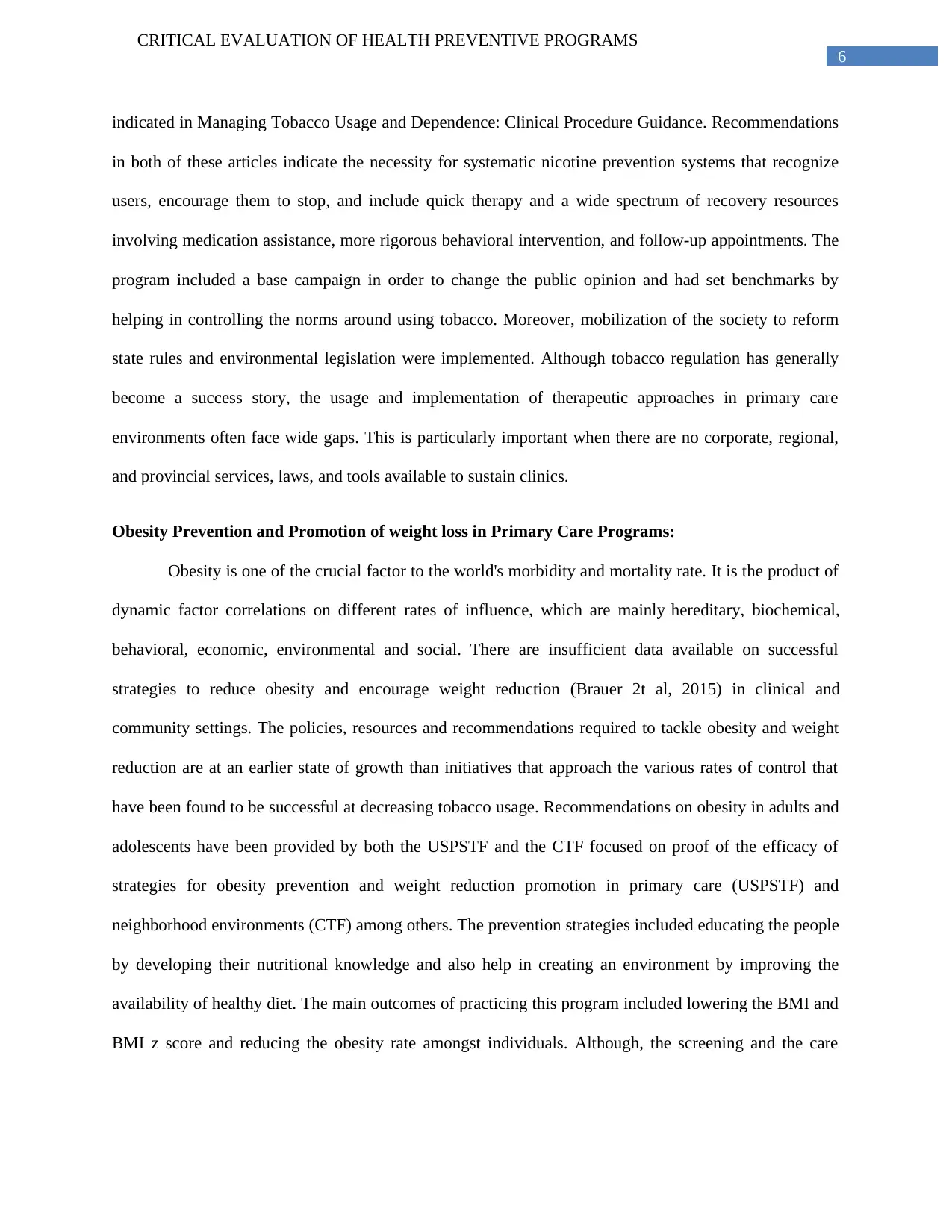
6
CRITICAL EVALUATION OF HEALTH PREVENTIVE PROGRAMS
indicated in Managing Tobacco Usage and Dependence: Clinical Procedure Guidance. Recommendations
in both of these articles indicate the necessity for systematic nicotine prevention systems that recognize
users, encourage them to stop, and include quick therapy and a wide spectrum of recovery resources
involving medication assistance, more rigorous behavioral intervention, and follow-up appointments. The
program included a base campaign in order to change the public opinion and had set benchmarks by
helping in controlling the norms around using tobacco. Moreover, mobilization of the society to reform
state rules and environmental legislation were implemented. Although tobacco regulation has generally
become a success story, the usage and implementation of therapeutic approaches in primary care
environments often face wide gaps. This is particularly important when there are no corporate, regional,
and provincial services, laws, and tools available to sustain clinics.
Obesity Prevention and Promotion of weight loss in Primary Care Programs:
Obesity is one of the crucial factor to the world's morbidity and mortality rate. It is the product of
dynamic factor correlations on different rates of influence, which are mainly hereditary, biochemical,
behavioral, economic, environmental and social. There are insufficient data available on successful
strategies to reduce obesity and encourage weight reduction (Brauer 2t al, 2015) in clinical and
community settings. The policies, resources and recommendations required to tackle obesity and weight
reduction are at an earlier state of growth than initiatives that approach the various rates of control that
have been found to be successful at decreasing tobacco usage. Recommendations on obesity in adults and
adolescents have been provided by both the USPSTF and the CTF focused on proof of the efficacy of
strategies for obesity prevention and weight reduction promotion in primary care (USPSTF) and
neighborhood environments (CTF) among others. The prevention strategies included educating the people
by developing their nutritional knowledge and also help in creating an environment by improving the
availability of healthy diet. The main outcomes of practicing this program included lowering the BMI and
BMI z score and reducing the obesity rate amongst individuals. Although, the screening and the care
CRITICAL EVALUATION OF HEALTH PREVENTIVE PROGRAMS
indicated in Managing Tobacco Usage and Dependence: Clinical Procedure Guidance. Recommendations
in both of these articles indicate the necessity for systematic nicotine prevention systems that recognize
users, encourage them to stop, and include quick therapy and a wide spectrum of recovery resources
involving medication assistance, more rigorous behavioral intervention, and follow-up appointments. The
program included a base campaign in order to change the public opinion and had set benchmarks by
helping in controlling the norms around using tobacco. Moreover, mobilization of the society to reform
state rules and environmental legislation were implemented. Although tobacco regulation has generally
become a success story, the usage and implementation of therapeutic approaches in primary care
environments often face wide gaps. This is particularly important when there are no corporate, regional,
and provincial services, laws, and tools available to sustain clinics.
Obesity Prevention and Promotion of weight loss in Primary Care Programs:
Obesity is one of the crucial factor to the world's morbidity and mortality rate. It is the product of
dynamic factor correlations on different rates of influence, which are mainly hereditary, biochemical,
behavioral, economic, environmental and social. There are insufficient data available on successful
strategies to reduce obesity and encourage weight reduction (Brauer 2t al, 2015) in clinical and
community settings. The policies, resources and recommendations required to tackle obesity and weight
reduction are at an earlier state of growth than initiatives that approach the various rates of control that
have been found to be successful at decreasing tobacco usage. Recommendations on obesity in adults and
adolescents have been provided by both the USPSTF and the CTF focused on proof of the efficacy of
strategies for obesity prevention and weight reduction promotion in primary care (USPSTF) and
neighborhood environments (CTF) among others. The prevention strategies included educating the people
by developing their nutritional knowledge and also help in creating an environment by improving the
availability of healthy diet. The main outcomes of practicing this program included lowering the BMI and
BMI z score and reducing the obesity rate amongst individuals. Although, the screening and the care
Paraphrase This Document
Need a fresh take? Get an instant paraphrase of this document with our AI Paraphraser
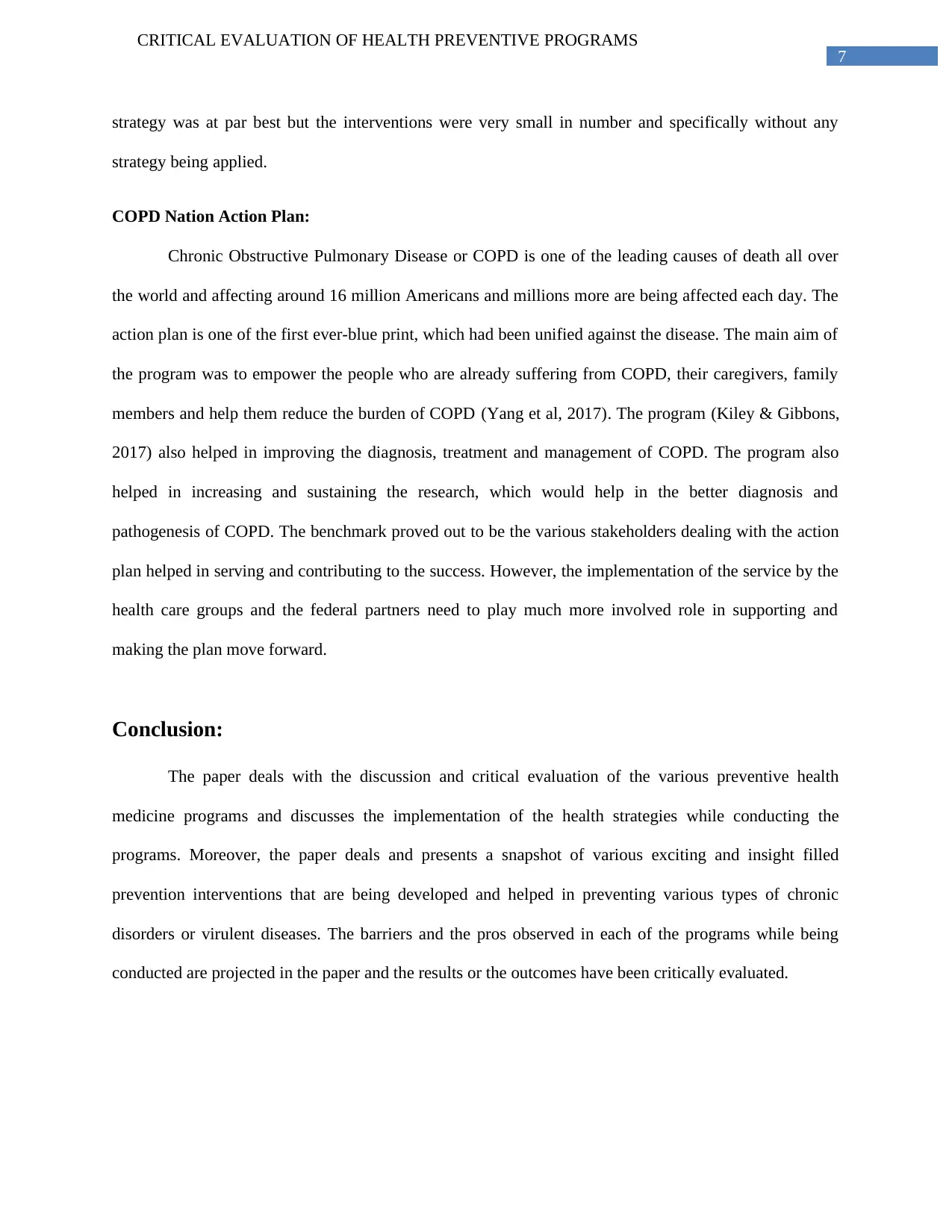
7
CRITICAL EVALUATION OF HEALTH PREVENTIVE PROGRAMS
strategy was at par best but the interventions were very small in number and specifically without any
strategy being applied.
COPD Nation Action Plan:
Chronic Obstructive Pulmonary Disease or COPD is one of the leading causes of death all over
the world and affecting around 16 million Americans and millions more are being affected each day. The
action plan is one of the first ever-blue print, which had been unified against the disease. The main aim of
the program was to empower the people who are already suffering from COPD, their caregivers, family
members and help them reduce the burden of COPD (Yang et al, 2017). The program (Kiley & Gibbons,
2017) also helped in improving the diagnosis, treatment and management of COPD. The program also
helped in increasing and sustaining the research, which would help in the better diagnosis and
pathogenesis of COPD. The benchmark proved out to be the various stakeholders dealing with the action
plan helped in serving and contributing to the success. However, the implementation of the service by the
health care groups and the federal partners need to play much more involved role in supporting and
making the plan move forward.
Conclusion:
The paper deals with the discussion and critical evaluation of the various preventive health
medicine programs and discusses the implementation of the health strategies while conducting the
programs. Moreover, the paper deals and presents a snapshot of various exciting and insight filled
prevention interventions that are being developed and helped in preventing various types of chronic
disorders or virulent diseases. The barriers and the pros observed in each of the programs while being
conducted are projected in the paper and the results or the outcomes have been critically evaluated.
CRITICAL EVALUATION OF HEALTH PREVENTIVE PROGRAMS
strategy was at par best but the interventions were very small in number and specifically without any
strategy being applied.
COPD Nation Action Plan:
Chronic Obstructive Pulmonary Disease or COPD is one of the leading causes of death all over
the world and affecting around 16 million Americans and millions more are being affected each day. The
action plan is one of the first ever-blue print, which had been unified against the disease. The main aim of
the program was to empower the people who are already suffering from COPD, their caregivers, family
members and help them reduce the burden of COPD (Yang et al, 2017). The program (Kiley & Gibbons,
2017) also helped in improving the diagnosis, treatment and management of COPD. The program also
helped in increasing and sustaining the research, which would help in the better diagnosis and
pathogenesis of COPD. The benchmark proved out to be the various stakeholders dealing with the action
plan helped in serving and contributing to the success. However, the implementation of the service by the
health care groups and the federal partners need to play much more involved role in supporting and
making the plan move forward.
Conclusion:
The paper deals with the discussion and critical evaluation of the various preventive health
medicine programs and discusses the implementation of the health strategies while conducting the
programs. Moreover, the paper deals and presents a snapshot of various exciting and insight filled
prevention interventions that are being developed and helped in preventing various types of chronic
disorders or virulent diseases. The barriers and the pros observed in each of the programs while being
conducted are projected in the paper and the results or the outcomes have been critically evaluated.
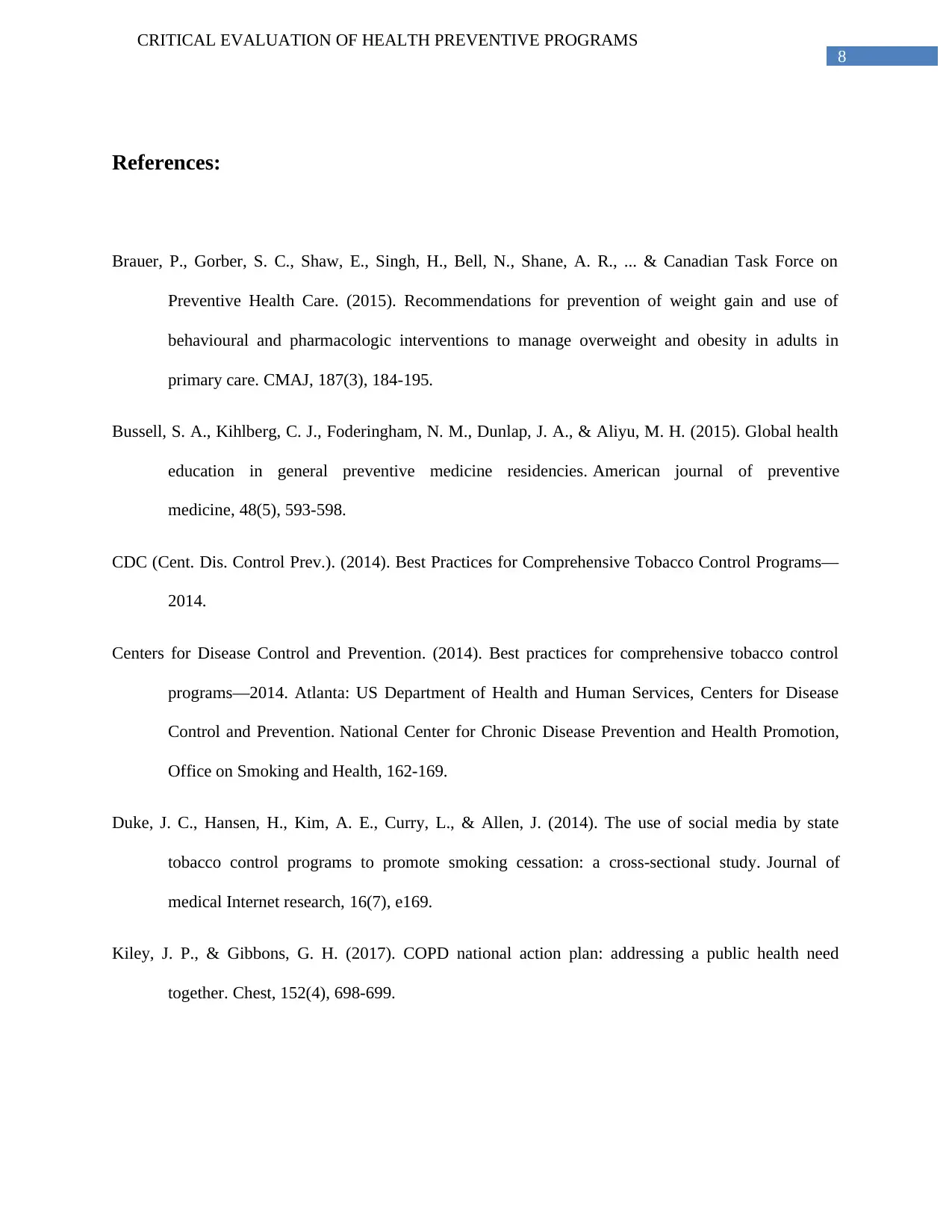
8
CRITICAL EVALUATION OF HEALTH PREVENTIVE PROGRAMS
References:
Brauer, P., Gorber, S. C., Shaw, E., Singh, H., Bell, N., Shane, A. R., ... & Canadian Task Force on
Preventive Health Care. (2015). Recommendations for prevention of weight gain and use of
behavioural and pharmacologic interventions to manage overweight and obesity in adults in
primary care. CMAJ, 187(3), 184-195.
Bussell, S. A., Kihlberg, C. J., Foderingham, N. M., Dunlap, J. A., & Aliyu, M. H. (2015). Global health
education in general preventive medicine residencies. American journal of preventive
medicine, 48(5), 593-598.
CDC (Cent. Dis. Control Prev.). (2014). Best Practices for Comprehensive Tobacco Control Programs—
2014.
Centers for Disease Control and Prevention. (2014). Best practices for comprehensive tobacco control
programs—2014. Atlanta: US Department of Health and Human Services, Centers for Disease
Control and Prevention. National Center for Chronic Disease Prevention and Health Promotion,
Office on Smoking and Health, 162-169.
Duke, J. C., Hansen, H., Kim, A. E., Curry, L., & Allen, J. (2014). The use of social media by state
tobacco control programs to promote smoking cessation: a cross-sectional study. Journal of
medical Internet research, 16(7), e169.
Kiley, J. P., & Gibbons, G. H. (2017). COPD national action plan: addressing a public health need
together. Chest, 152(4), 698-699.
CRITICAL EVALUATION OF HEALTH PREVENTIVE PROGRAMS
References:
Brauer, P., Gorber, S. C., Shaw, E., Singh, H., Bell, N., Shane, A. R., ... & Canadian Task Force on
Preventive Health Care. (2015). Recommendations for prevention of weight gain and use of
behavioural and pharmacologic interventions to manage overweight and obesity in adults in
primary care. CMAJ, 187(3), 184-195.
Bussell, S. A., Kihlberg, C. J., Foderingham, N. M., Dunlap, J. A., & Aliyu, M. H. (2015). Global health
education in general preventive medicine residencies. American journal of preventive
medicine, 48(5), 593-598.
CDC (Cent. Dis. Control Prev.). (2014). Best Practices for Comprehensive Tobacco Control Programs—
2014.
Centers for Disease Control and Prevention. (2014). Best practices for comprehensive tobacco control
programs—2014. Atlanta: US Department of Health and Human Services, Centers for Disease
Control and Prevention. National Center for Chronic Disease Prevention and Health Promotion,
Office on Smoking and Health, 162-169.
Duke, J. C., Hansen, H., Kim, A. E., Curry, L., & Allen, J. (2014). The use of social media by state
tobacco control programs to promote smoking cessation: a cross-sectional study. Journal of
medical Internet research, 16(7), e169.
Kiley, J. P., & Gibbons, G. H. (2017). COPD national action plan: addressing a public health need
together. Chest, 152(4), 698-699.
⊘ This is a preview!⊘
Do you want full access?
Subscribe today to unlock all pages.

Trusted by 1+ million students worldwide
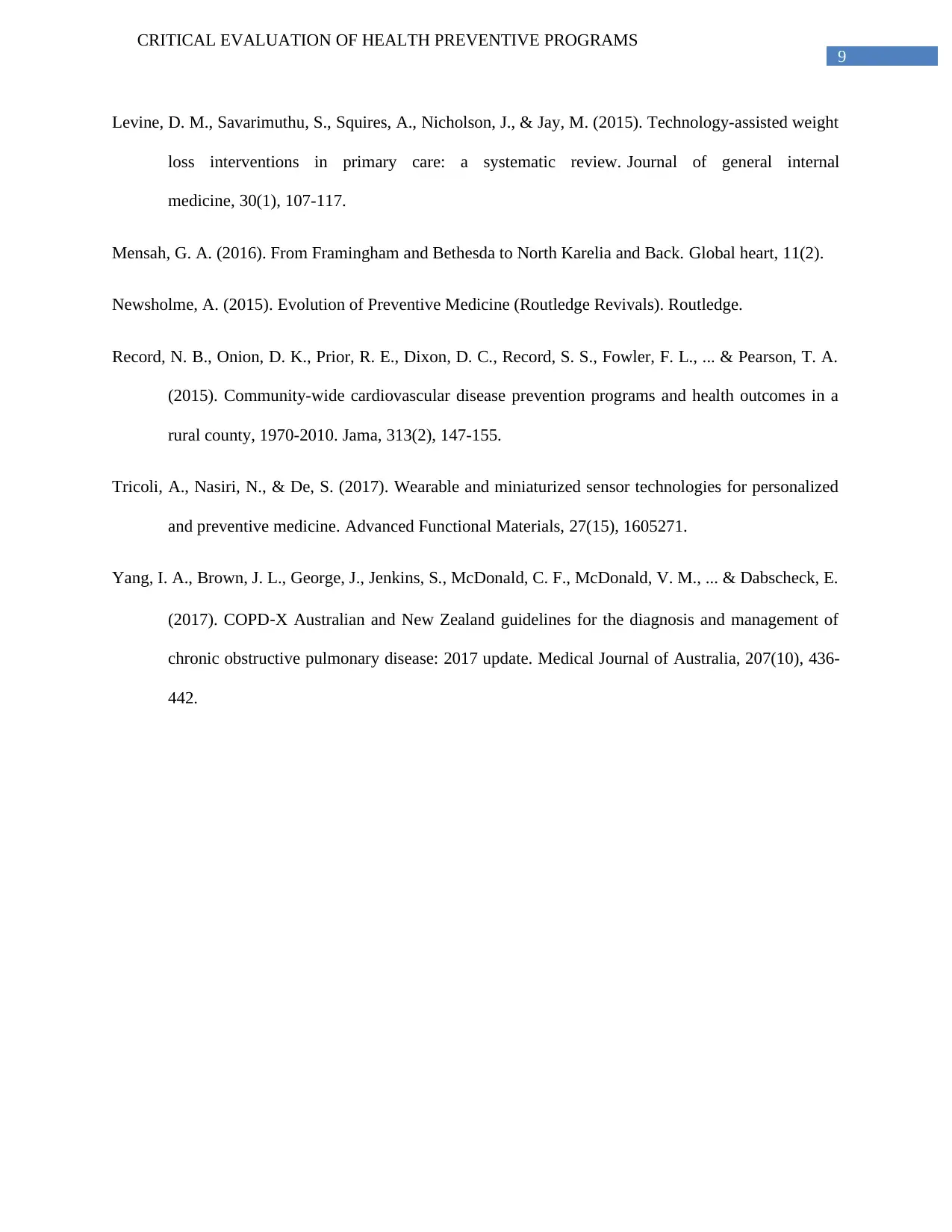
9
CRITICAL EVALUATION OF HEALTH PREVENTIVE PROGRAMS
Levine, D. M., Savarimuthu, S., Squires, A., Nicholson, J., & Jay, M. (2015). Technology-assisted weight
loss interventions in primary care: a systematic review. Journal of general internal
medicine, 30(1), 107-117.
Mensah, G. A. (2016). From Framingham and Bethesda to North Karelia and Back. Global heart, 11(2).
Newsholme, A. (2015). Evolution of Preventive Medicine (Routledge Revivals). Routledge.
Record, N. B., Onion, D. K., Prior, R. E., Dixon, D. C., Record, S. S., Fowler, F. L., ... & Pearson, T. A.
(2015). Community-wide cardiovascular disease prevention programs and health outcomes in a
rural county, 1970-2010. Jama, 313(2), 147-155.
Tricoli, A., Nasiri, N., & De, S. (2017). Wearable and miniaturized sensor technologies for personalized
and preventive medicine. Advanced Functional Materials, 27(15), 1605271.
Yang, I. A., Brown, J. L., George, J., Jenkins, S., McDonald, C. F., McDonald, V. M., ... & Dabscheck, E.
(2017). COPD‐X Australian and New Zealand guidelines for the diagnosis and management of
chronic obstructive pulmonary disease: 2017 update. Medical Journal of Australia, 207(10), 436-
442.
CRITICAL EVALUATION OF HEALTH PREVENTIVE PROGRAMS
Levine, D. M., Savarimuthu, S., Squires, A., Nicholson, J., & Jay, M. (2015). Technology-assisted weight
loss interventions in primary care: a systematic review. Journal of general internal
medicine, 30(1), 107-117.
Mensah, G. A. (2016). From Framingham and Bethesda to North Karelia and Back. Global heart, 11(2).
Newsholme, A. (2015). Evolution of Preventive Medicine (Routledge Revivals). Routledge.
Record, N. B., Onion, D. K., Prior, R. E., Dixon, D. C., Record, S. S., Fowler, F. L., ... & Pearson, T. A.
(2015). Community-wide cardiovascular disease prevention programs and health outcomes in a
rural county, 1970-2010. Jama, 313(2), 147-155.
Tricoli, A., Nasiri, N., & De, S. (2017). Wearable and miniaturized sensor technologies for personalized
and preventive medicine. Advanced Functional Materials, 27(15), 1605271.
Yang, I. A., Brown, J. L., George, J., Jenkins, S., McDonald, C. F., McDonald, V. M., ... & Dabscheck, E.
(2017). COPD‐X Australian and New Zealand guidelines for the diagnosis and management of
chronic obstructive pulmonary disease: 2017 update. Medical Journal of Australia, 207(10), 436-
442.
1 out of 10
Related Documents
Your All-in-One AI-Powered Toolkit for Academic Success.
+13062052269
info@desklib.com
Available 24*7 on WhatsApp / Email
![[object Object]](/_next/static/media/star-bottom.7253800d.svg)
Unlock your academic potential
Copyright © 2020–2025 A2Z Services. All Rights Reserved. Developed and managed by ZUCOL.





